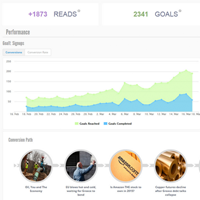The money is in the list.
How many times have you heard that?
The reason internet marketers go on about growing your email list is because a large email list is such a powerful tool. It allows you to send a ton of traffic to any article you publish. It allows you to advise thousands of people about a new product you are selling. You can even earn thousands of dollars in minutes with a simple email blast. In short, a large email list allows you to connect to your audience directly and build a long trusting and profitable relationship over time.

In this article, I would like to do a small case study that focuses on removing dead weight from your email list.
A Healthy Email List
One important part of email marketing is attracting more people to join your email list. More subscribers means more traffic and more income.
But attracting more people to join your email list is not only about increasing numbers. It is also about maintaining traffic and maintaining income, as over time, click through rates and conversion rates decrease because people become less responsive to your emails.
There are a number of reasons for this:
- Some subscribers may not be interested in what you have to say
- Some subscribers receive too many emails
- Some subscribers only signed up for a free gift and have no interest in you or your services
- Some subscribers change their email address and no longer use the email address they registered with
- Some subscribers forgot they signed up to your email list
- Some subscribers use a fake or temporary email address for signing up to newsletters
If you send your email newsletter using a popular email marketing service, subscribers will see a a message at the bottom of every email you send that states that they can unsubscribe if they like by clicking on the link provided.
In a perfect world, anyone who did not want stay on your email list would use the unsubscribe link that is provided and remove themselves from your list. Sadly, that is not what the majority of people do. It is more common for people to simply ignore your emails, delete them, or report them as spam. This leads to higher bounce rates, lower open rates, lower click through rates, and lower conversion rates. In the end, the high volume of subscribers on your email list becomes nothing more than an ego boost.

Having a high number of subscribers also increases your email marketing expenses. Take GetResponse, for example, which is the email marketing company I am currently using (despite the numerous problems I have had with them).
GetResponse charge me $45 per month because I have more than 2,5000 subscribers. This fee would reduce to $25 per month if the total number of subscribers on my email lists dropped to under 2,500. Therefore, I could potentially save $200 per year by removing subscribers who no longer read my emails.
Those of you with large email lists could potentially save thousands of dollars per year by removing inactive subscribers. That is a significant saving for any business.
Cleaning an email list not only saves you money. It will also greatly reduce bounce rates, increase conversion rates, and reduce complaints to your email marketing service (yes, people who signed up to your email list can and will complain you are spamming them).
Hesitations About Removing Subscribers
I have always had some reservations about removing subscribers from an email list as there is always a part of me that thinks “Maybe those unresponsive subscribers will respond if I send a good deal or enticing offer”. In reality, that never happens. If someone has not opened your emails for months or even years, your emails are probably going straight to their spam folder.
I spoke about this issue recently with Colm Troy from CommerceGurus when we both attended WordCamp in Spain. Colm gave me some great advice about the issue.
He advised me to:
- Create a list of people who have not opened one of my emails in three months
- Remove all of those people from my main email list
- Send an email blast to the new group advising them to re-confirm to my main email list
These steps will remove all of the people who are no longer actively reading my emails. I could, of course, change the time period from three months to something different, be it one month, two months, six months, or whatever. However, I believe three months is a good starting point.
So I asked myself the same question that many of you will ask yourselves: Is it worth cleaning my email list?
A quick look at my email delivery statistics highlights why cleaning the email list for this blog is long overdue.
I have over three thousand subscribers to this blog’s newsletter. It’s not an amazing amount, but it is high enough for me to expect to receive traffic when I send out an email. Unfortunately, my open rates are pretty poor.
The screenshot below was taken from my GetResponse account. It shows an email I sent in June about an opportunity to win one of three developer licenses from Elegant Themes. It was a pretty good competition and should have gotten a good response. Sadly, it did not.
It had a 1.98% open rate and a 2.24% click rate. Of the 2,703 emails that were sent, 378 emails bounced (13.98%); which effectively means those emails are dead (more on this issue later). 46 people in total opened the email that was sent, which generated 52 clicks. 3 people also unsubscribed, which is normal for an email blast of this size.
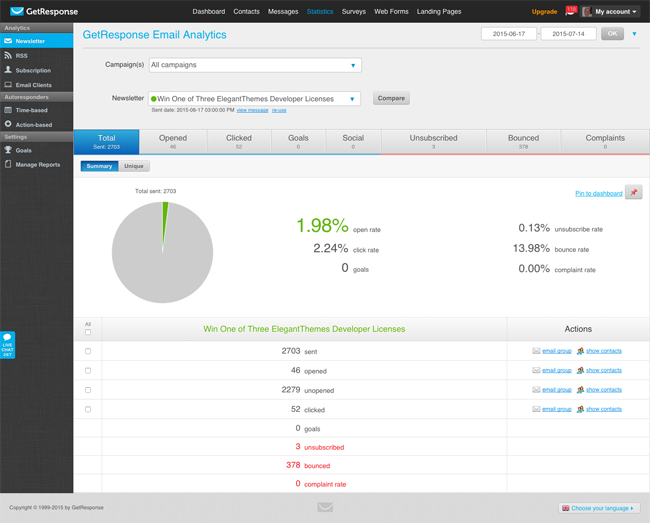
I also send a weekly newsletter that is generated through the RSS feed of this blog.
When I checked the stats for my RSS feed, I saw a much higher open rate of 17.19%. Unfortunately, the click through rate was still very low at 2.44%.
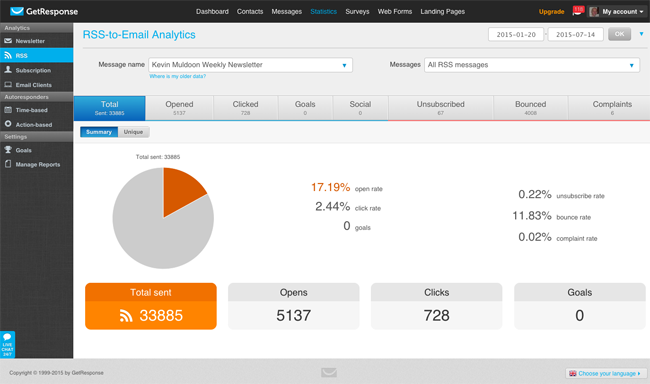
The above stats are a little misleading as they take into account all of the RSS-to-Email newsletters I have sent through GetResponse. When I filter the data to show stats for the last four RSS-to-Email newsletters, my numbers go down. The screenshot below shows you how different stats are for my last four weekly newsletters.
My open rate has only been 13.14% and my click rate has only been 1.40%. The bounce rate of 13.81% is almost identical to the bounce rate I saw with my last email blast. This backs up the idea that all of the emails that are bouncing are dead.
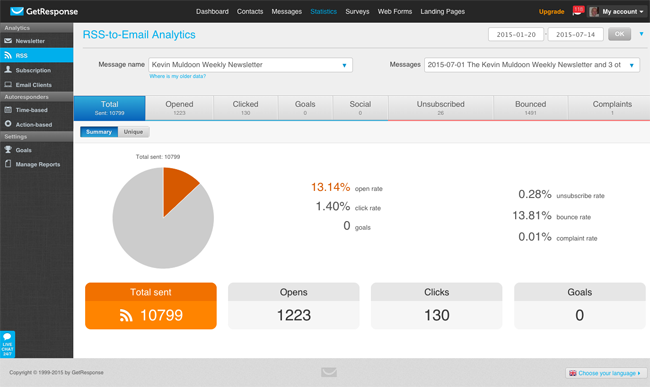
These stats more than convinced me that an email clean up was long overdue.
Moving Unresponsive Subscribers to a New List
Email marketing services provide tools to help you filter your contacts and see who is opening your emails and who is not. You can then move subscribers to a new campaign and then delete them from your main email list.
The steps involved are slightly different for each email marketing service, but by and large the process is the same. I will be using GetResponse for illustration purposes.
On GetResponse, you go to the main navigation menu and go to “Contacts” and then click on “Search Contacts”. I then click on “Advanced Search”.
There are a few things I need to define in my filter:
- The campaign
- The subscription date
- The last open date
By default, GetResponse will search all of my email campaigns. I therefore need to ensure that I only select the campaign that I use for this blog, not for other websites I own.
The subscription date allows me to filter results using the date a person signed up to my list. I want to exclude people who have only recently signed up to my list. Finally, I want to define the last open date for a cutoff point.
I began writing this case study on the 16th July 2015. I therefore chose 16th April as my cutoff point for both my last open date and subscription date. That means that anyone who signed up to my email list is not included in this filter and it means that anyone who signed up before and has not opened an email since then will be included.
Lastly, you need to add a condition. GetResponse offers a lot condition options, such as location, last open date, last click date, bounces, and more.
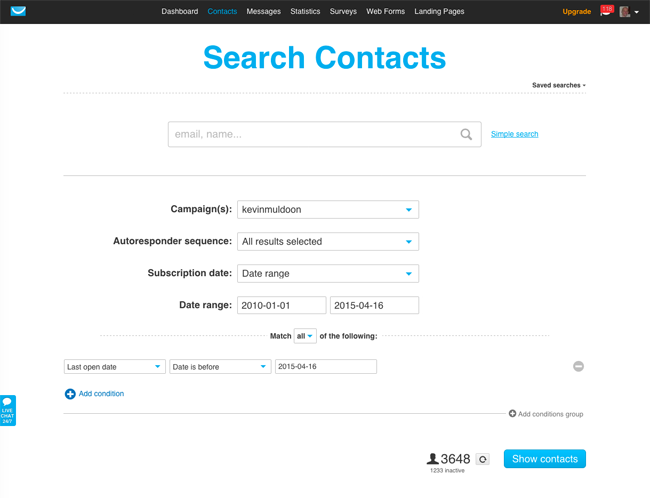
The filters and last open date condition brought up a total of 1,070 subscribers. That’s around a third of the total size of my email list.
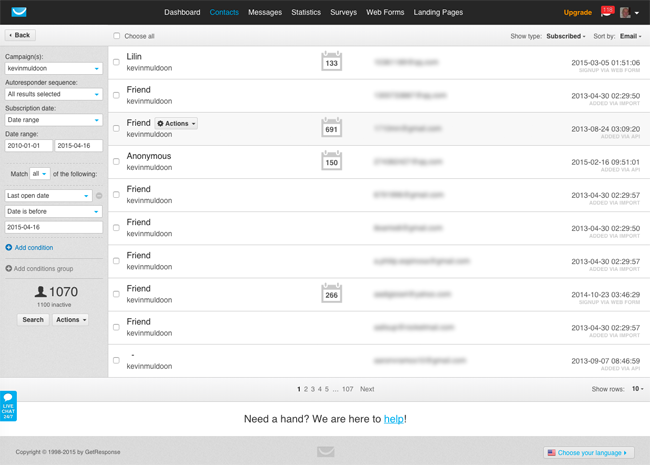
We next need to copy these subscribers to a new campaign. Unfortunately, GetResponse does not allow me to create a new campaign through the contact search results page. I therefore opened GetResponse in a new campaign and created a new campaign through the main menu at the top right hand side of the page.
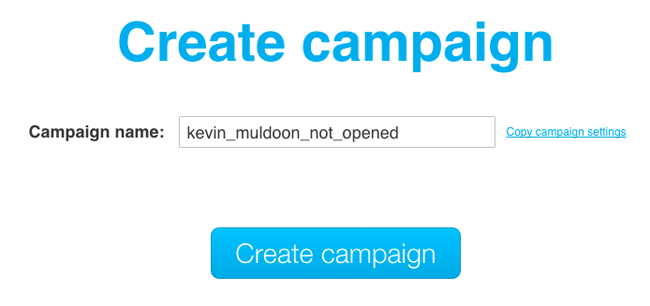
Annoyingly, the new campaign I created would not appear as an option in the contact search results page. I therefore had to go back and perform the search again.
At the bottom of the left menu is an action drop down menu. GetResponse gave me two options: “Copy to campaign” or “Move to campaign”. Moving contacts is the better option as it means you don’t have to go back and delete them from your main campaign.
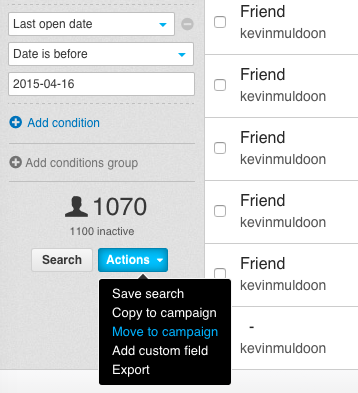
I then selected the new campaign I just created.

GetResponse moved my subscribers over to my new campaign immediately.

All of the subscribers who have not opened my emails within the last three months have been removed from my main email list. This means that my email list is smaller, but it also means it should be more responsive.
The next thing I need to do is email all of those people who did not open my emails and ask if they want to resubscribe to my main email list.
Emailing the Unresponsive Subscribers
At this point, I ran into a slight problem.
I had assumed that I would be able to send an email to the people I removed from my main email list with a confirmation URL. Subscribers could then click on the confirmation link in order to re-subscribe to my newsletter.
Unfortunately, GetResponse does not offer that functionality. When I queried the issue, they said:
Hello,
Thank you for contacting GetResponse.
It’s not possible to manually send them a confirmation link like that unfortunately. You’d have to direct them to a website or landing page that allows them to fill out a webform to sign up for the campaigns you want them in.
I hope this helps! If you need anything else, please let us know.
Cheers,
Customer Success Team
What I had to do instead is send an email to those 1,070 subscribers asking them to sign up again on the newsletter page of my blog.
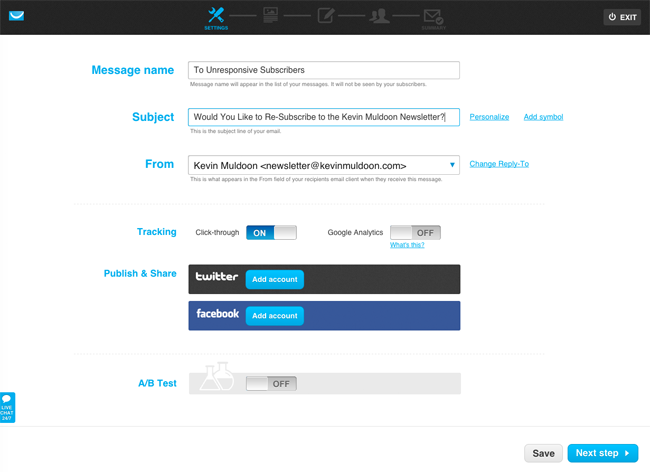
The email you send to the subscribers you removed from your main email list can be as short as long as you wish’ though I think it makes sense to keep the email short and to the point.
This is the email I sent to my unresponsive subscribers:
Hi there.
My name is Kevin Muldoon (from www.kevinmuldoon.com). You have been subscribed to my email newsletter for some time, however I noticed that you have not opened any of my emails for many months.
As such, you have been removed from my newsletter. I am sad to see you go, but I appreciate that you may not be interested in my emails anymore.
Should you wish to sign up again, please sign up at https://www.kevinmuldoon.com/newsletter/
Thanks,
Kevin
I scheduled my email to deliver on a Saturday afternoon at 12pm local time using GetResponse’s time travel feature. This means that the email will be delivered at midday in the subscriber’s time zone.
My Unopened Email List
Last week, I removed all of the unresponsive subscribers from my email list and emailed them with a request to sign back up again if they would like to continue receiving my newsletters.
If I wish, I could simply delete this campaign now, however I believe it is more practical to keep the list. I can delete all of the subscribers from the campaign and every few months I can perform these steps again to remove subscribers from my newsletter who are not reading my emails.
Removing Bounced Subscribers
I had assumed that the majority of the bounced email subscribers would have been removed when I removed those those 1,070 subscribers. Unfortunately, that was not the case.
When I sent an email to subscribers to advise them about my CloudPress competition, 245 email addresses bounced. This is a reduction on the 378 emails that were bouncing before I cleaned my list, however I was surprised that the number was so high.
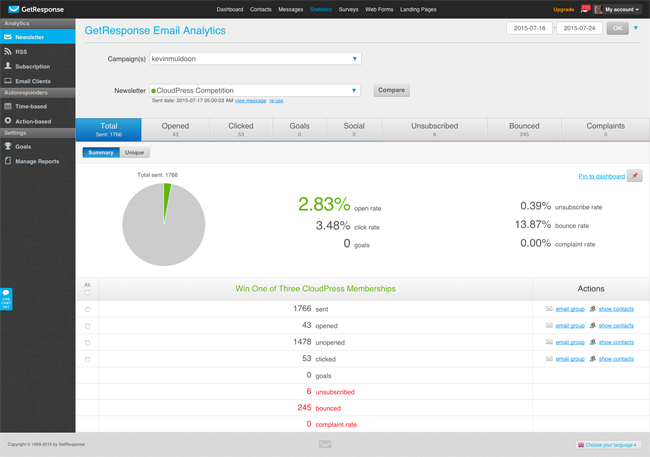
Email marketing services split bounced emails into two categories: Hard bounces and soft bounces. Hard bounces usually refer to fake email addresses, emails attached to domains that no longer exist, or emails in which the mail server blocked delivery.
Soft bounces generally refer to a temporary delivery issue. For example, if the email server is offline when you attempted to deliver the email, if the user’s inbox is full, or if the email you send is too large (more likely to occur when you attach files).
I did a new search on GetResponse to find bounced email addresses. In total, GetResponse listed 446 email addresses as bounced.
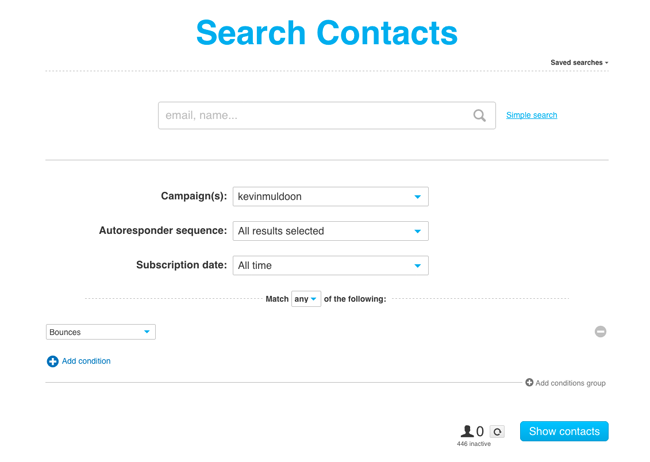
GetResponse did not appear to distinguish between soft and hard bounces in their search results. I therefore contacted them for confirmation as to whether there was any way for me to see which bounces were hard (i.e. permanent) and which were soft (i.e. temporary).
Thank you for contacting GetResponse!
Only hard bounces will be visible in your account. You won’t be able to see the soft bounces until they hard bounce.
“Bounces” are emails that are returned to the sender because they cannot be delivered for some reason. Bounces fall into 2 categories. Hard bounces are
permanent returns- for instance an email address not existing or being deleted.Soft bounces are usually temporary issues such as a full inbox or the mail server being temporarily unavailable (due to maintenance or some other issue). In case of a soft bounce, we will try at least three times to deliver the message before transferring the contact onto the unconfirmed list.
Addresses that are hard bounced will automatically be removed from your list.
I hope this helps! If you need anything else, please let us know.
Upon further inspection, I noticed that not only do the GetResponse search results show hard bounces, they also let you filter emails by the reason they bounced. You can choose “Mailbox is full”, “Other reason”, “Email address recycled” and “Address unknown”.
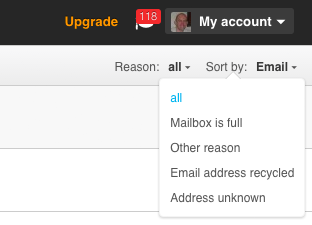
I did not want to remove email addresses who had been marked as “Mailbox is full” in case it was a temporary issue. However, I was unable to move bounced emails to another email campaign or delete bounced emails. GetResponse themselves said that “Addresses that are hard bounced will automatically be removed from your list”.
That is a good feature to have, however it raised the question as to why hundreds of bounced email addresses in my email list were not being deleted automatically. Clearly, the vast majority of the 446 bounced email addresses on my list should have been deleted a long time ago (particularly when consider my list only grows by around 60 subscribers per month).
GetResponse advised me that they retain information about bounced email addresses so that they are not registered as subscribers again. They also said that the bounced emails in my campaign statistics are soft bounces; however, this does not explain why I receive hundreds of soft bounces every email blast.
After a dozen or so emails back and fourth, they finally admitted their was a problem on their side.
I am contacting you regarding a task that has been created for our IT to investigate the issue you reported. I am happy to confirm the issue has
been fixed and the bounce rate should go down starting from the next mailout.We appreciate any feedback you may have and are sorry for any inconvenience this might have caused.
In future emails, I should see my bounce rates drop dramatically because this error is no longer there (fingers crossed).
Papering Over the Cracks
Before I begin any case study, I always have hope that everything will turn out well as it is good to show people that everything turned out the way you expected it to.
I intended this case study to show that my email list was carrying a lot of dead weight. It had a lot of subscribers who were no longer interested in my newsletters and a lot of emails that were no longer valid.
In that respect, I believe I have shown the benefits of regularly cleaning your email list and removing people who are not opening your emails. There really is no need to keep paying more to your email marketing service for subscribers that have no interest in receiving emails from you.
However, this case study has also highlighted how unresponsive most subscribers to my newsletter are to my emails.
In hindsight, I was a complete idiot to think that removing a thousand subscribers would somehow greatly improve my open rates to the point where my open numbers would be acceptable. Nothing would change the fact that only 46 people opened my email blast about the Elegant Themes competition. Sure, removing the dead weight is still something we should be striving for, but I am still only papering over the cracks.
The big problem is that most of the people who are signing up to my newsletter are not interested in the emails I send. This could be for a number of reasons. It could be because they do not enjoy my automatically generated weekly newsletter, it could be because I do not email them regularly with good tips, or it could be because they only signed up to download my free eBook. I do not want to dwell too long on the reasons in this particular article, however it is clear that it is something I need to examine.
On the plus side, I now know the true benefits of my email newsletter. I may not longer have over 3,000 subscribers, but I now know that there are nearly 50 people who enjoy receiving my emails. From now on, that is the real number I will be focusing on when I look at my newsletter statistics.
Thanks for reading.
Kevin

